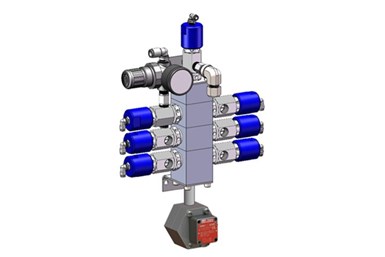How to Reduce Waste for Two-Component Coatings
John Owed of Carlisle Fluid Technology suggests fluid metering equipment to reduce solvent and coating waste for multiple-component coatings.
Q: We are spraying two-component primers and topcoats, and despite our best efforts to properly estimate the amount needed, we end up scrapping 3-5 gallons of coating each day. In addition to the wasted paint, we also use a high volume of solvent to clean our tanks and guns. How can we reduce the amount of waste in our process?
A. The situation you have described is very common and is directly related to your process of “hot potting” or manually blending the “A” and “B” parts of a two-component material. Once the two materials are combined or activated, you have a fixed amount of time or “pot life” to apply the “hot” material. Hot potting is a very easy and cost-effective way to mix and spray two-component materials until it becomes a financial burden as you have described. Another disadvantage of “hot potting” that you may have noticed is that, over a short period of time, the viscosity of the material changes, which directly impacts the spray and finish quality.

Typical manifold assembly with flow meter, which can accommodate multiple materials in addition to air and solvent valves used for flushing.
Photo Credit: Carlisle Fluid TechnologyThere is a wide variety of mechanical and electronic fluid metering equipment that will resolve the issue that you are experiencing. These systems allow you to mix the material as it is being applied, which drastically reduces the amount of waste generated. Since the material is mixed on demand, you will also have much better consistency, which will improve the overall application process and finish quality.
The most versatile unit would be an electronically based unit. In addition to mixing the materials on demand, these units can store multiple recipes or settings for a wide range of coatings which may have different mix ratios. Once configured, most systems can provide reporting on material usage, which can be a great aid for environmental reporting and understanding of true finishing cost.
Additionally, the fluid section of the machine can be provided with a valve manifold that allows for multiple colors (“A” component) to be loaded up to the machine. The manifolds can be supplied from pressure pots, pumps or a combination of the two depending on the volume of material needed. The catalyst or “B” component is also fed to a separate manifold. The materials are then run from the manifolds through independent meters (which measure the volume of material) and regulators (used to adjust flow) to a mix-block assembly, at which point the two materials are combined. The outlet of the mix manifold supplies the activated material to the paint applicators. Multiple applicators can be supplied from a single machine.
With this type of system, color change, flushing time and the amount of waste generated are greatly reduced. The amount of material lost per color change is equal to the volume of material within the system from the outlet of the manifold to the applicator. During the automated flushing process, solvent and air are used in combination to create a scrubbing action that can reduce solvent usage and cleaning time by up to 65%.
The purchase of a fluid metering system can typically be justified based on reduced paint waste alone. For example, you noted that you waste 3–5 gallons a day of mixed material. Let’s take the average of 4 gallons and assume that even with a metering system you will still have some loss (material in lines), as noted above. For this example, we will use 3.5 gallons a day of waste and assume a price of $65 per mixed gallon: 3.5 gallons x $65./Gallon x 260 days per year = $59,150 in coating savings alone (910 less gallons per year wasted).
Additional justification can also be gained from:
- Reduced waste disposal costs caused by less waste
- Reduced solvent usage
- Reduce waste solvent disposal
- Reduced color change time. Typically, an automated color change can be done in less than 1 minute with minimal solvent usage.
I would certainly encourage you to reach out to your local equipment supplier and identify a fluid metering system that will meet your requirements. You should be prepared to provide the following information to aid in the specification of a machine:
- Number of colors
- Number of catalysts
- Viscosity of materials to be applied
- Mix ratio of materials to be applied
- Minimum and maximum flow rate required
- Number of applicators to be supplied
Based on the information above and some additional details about your process, you should be able to obtain an equipment proposal. Additional information on current solvent usage, disposal cost, color change time and related labor can be used to identify a more in-depth cost analysis for project justification.
About the Author

John Owed
John Owed has over 10 years of experience in finishing, and is currently the finishing SBU director at Carlisle Fluid Technologies.
Related Content
Conveyors and Paint Systems
Choosing the right conveyor system, coating technology, and ancillary equipment.
Read MoreTop Reasons to Switch to a Better Cleaning Fluid
Venesia Hurtubise from MicroCare says switching to the new modern cleaning fluids will have a positive impact on your cleaning process.
Read MoreUnderstanding and Managing White Spots on Anodized Aluminum
Having trouble with spotting defects when anodizing? Taj Patel of Techevon LLC offers a helpful overview of the various causes of white spots and potential solutions.
Read MoreHow to Maximize Nickel Plating Performance
The advantages of boric acid-free nickel plating include allowing manufacturers who utilize nickel plating to keep up the ever-changing regulatory policies and support sustainability efforts.
Read MoreRead Next
Delivering Increased Benefits to Greenhouse Films
Baystar's Borstar technology is helping customers deliver better, more reliable production methods to greenhouse agriculture.
Read MoreEpisode 45: An Interview with Chandler Mancuso, MacDermid Envio Solutions
Chandler Mancuso, technical director with MacDermid Envio discusses updating your wastewater treatment system and implementing materials recycling solutions to increase efficiencies, control costs and reduce environmental impact.
Read MoreA ‘Clean’ Agenda Offers Unique Presentations in Chicago
The 2024 Parts Cleaning Conference, co-located with the International Manufacturing Technology Show, includes presentations by several speakers who are new to the conference and topics that have not been covered in past editions of this event.
Read More





















